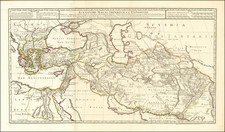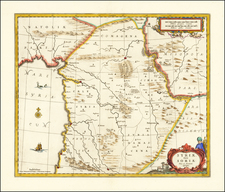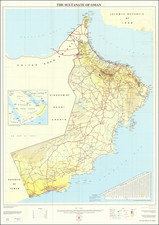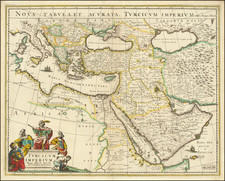True First State of the Earliest Woodblock Printed Map of the Arabian Peninsula
Stunning map of the Arabian Peninsula, the first woodblock printed depiction of the region, in spectacular contemporary hand-coloring.
The map is from the rare 1482 Ulm edition of Ptolemy’s Geographia, the first atlas printed north of the Alps and the first to contain illustrated woodcut maps. It contains the traditional 27 Ptolemaic maps, of which this example is one, and five additional modern maps: Italy, Spain, France, Scandinavia, and the Holy Land. This map is the most famous and highly-sought after of all fifteenth-century maps of the region.
The Ulm Ptolemy was innovative as it was intended to be colored, with instructions from the publisher as to how to embellish the woodcut print. The seas are colored a rich blue using expensive and scarce lapis lazuli as the coloring agent.
The Arabian Peninsula, Arabia Felix, is in pride of place here, surrounded by the waters of the Red Sea, Gulf of Aden, Arabian Sea, Gulf of Oman, and the Persian Gulf, to use their modern names. All labels on the map are in Latin, the language of learned knowledge in the fifteenth century.
Islands surround the peninsula. Additionally, portions of Ethiopia and Carmania, a region in Persia (modern Iran), ring the edges of the map. Towns and political units are marked, with larger titles of bodies of water and landmasses labeled with woodblock titles inserted in the larger block.
A border of latitude and longitude lines frames the map, an innovation in cartography traceable to Ptolemy, whose influence in the history of cartography cannot be overstated.
As noted below, the first state of the map lacks the title and almost always appears with the ocean colored in a brilliant Lapis Lazuli blue, a semi-precious stone which was ground to a fine powder, in order to make the rarest and most expensive color which was then being applied by 15th and 16th colorists. The stones from which the color was ground was typically imported from the Sar-i Sang mines in the Indus Valley and Badakhshan regions of Afghanistan. The intense blue color is due to the presence of the trisulfur radical anion in the crystal.
Ptolemy in Europe in the Fifteenth Century
The fifteenth century is an important one for the history of cartography for two main reasons. The first is the re-discovery of Ptolemy’s work by Europeans. The second, which roughly coincides with the re-encounter of Ptolemy, is the invention of the printing press by Johannes Gutenberg in ca. 1440.
Ptolemy’s ideas had been absent from western European intellectual history for roughly a thousand years, although Arab scholars interacted with his ideas from the ninth century onward. In 1295, a Greek monk found a copy of Ptolemy in Constantinople; the emperor ordered a copy made and the Greek text began to circulate in eastern Europe. In 1393, a Byzantine diplomat brought a copy of the Geographia to Italy, where it was translated into Latin in 1406 and called the Cosmographia. The manuscript maps were first recorded in 1415. These manuscripts, of which there are over eighty extant today, are the descendants of Ptolemy’s work and a now-lost atlas consisting of a world map and 26 regional maps.
When Ptolemy’s work was re-introduced to Western scholarship, it proved radically influential for the understanding and appearance of maps. Ptolemy employs the concept of a graticule, uses latitude and longitude, and orients his maps to the north—concepts we take for granted today. The Geographia’s text is concerned with three main issues with regard to geography: the size and shape of the earth; map projection, i.e. how to represent the world’s curve proportionally on a plane surface; and the corruption of spatial data as it transfers from source to source. The text also contains instructions as to how to map the world on a globe or a plane surface, complete with the only set of geographic coordinates (8000 toponyms, 6400 with coordinates) to survive from the classical world.
Early printed editions of Ptolemy’s Geographia
Some of the most important, and the most numerous, early printed maps were in editions of Ptolemy’s Geographia (Cosmographia); indeed, 31 editions of the work with the maps were printed before 1600. Some of the most important, and rarest, of these editions, including the Ulm Ptolemy from which this map originated, were the earliest editions of the work ever printed.
The text was first published in 1475 in Venice without the maps. An edition with the maps followed in 1477, printed in Bologna. These maps were another first—they were the first copperplate maps, in which an engraver scores copper, which is then inked and pressed. The Bologna edition included 25 of the original 26 regional maps (map XV was missing), as well as the world map.
A second edition with maps appeared in Rome in 1478. The third edition with maps was printed in Florence in 1482, the first to be printed in a vernacular language, Italian. It included 31 copperplate engraved maps, making it the first to augment the traditional 27 Ptolemaic maps with tabulae novellae, or modern maps. The modern maps included maps of Italy, Spain, and France.
The next edition to include the maps was the one from which this map originated, the 1482 Ulm edition. As stated above, this was the first atlas to be printed north of the Alps, as well as the first to use woodcut, not copperplate, printing. Copperplate engraving is an intaglio method; it cuts into the surface of the printing plane in order to create an impression when the engraved lines are inked. Woodcut engraving is a relief method; the surfaces to be inked are left standing, while the blank spaces are cut away.
The Ulm edition is based on a manuscript original by Dominus Nicolaus Germanus, a German Benedictine monk who created the tome in the early 1470s. The manuscript is held in Wurtemberg. Other of Germanus’ Ptolemaic manuscripts, of which there are five, most likely also served as the templates for the Bologna 1477 and the Rome 1478.
The Ulm is also important for its world map is the earliest printed map to be signed by its maker, Johannes Schnitzer. The publication was the first project of Lienhart Holle, who had previously worked as a woodcut engraver. He wanted the work to be grand. A new type was cut for the atlas, and Holle oversaw the coloring of deluxe examples of the print run. However, the expense involved in the producing the book was a bit too grand; Holle went bankrupt after printing just one other book and his stock was taken over by Johann Reger, who re-issued the atlas in 1486.
The Two States of this Map
The 1482 first edition can be readily differentiated from the 1486 second edition by the lack of a printed title above the map image in the upper margin. In the 1486 edition, the title reads "♦SEXTA♦ASIE♦" on the left-hand side of the page and "♦TABULA♦" on the right-hand side. Additionally, the coloring on the two maps differed; while the seas are blue in the 1482 edition, they are brown in color on the 1486.
This map is innovative and dynamic, the first woodcut map of the Arabian Peninsula. It was part of a historically-important atlas which was central to the development of cartography in Europe during the fifteenth century and would make a significant addition to any collection of Ptolemaic, Arabian Peninsula, Middle Eastern, or early printed maps.
Rarity
Fine examples of the first state of the map are now quite rare on the market.
Claudius Ptolemy (fl. AD 127-145) was an ancient geographer, astronomer, and mathematician. He is known today through translations and transcriptions of his work, but little is known about his life besides his residence in Alexandria.
Several of his works are still known today, although they have passed through several alterations and languages over the centuries. The Almagest, in thirteen books, discusses astronomy. It is in the Almagest that Ptolemy postulates his geocentric universe. His geometric ideas are contained in the Analemma, and his optical ideas were presented in five books known as the Optica.
His geographic and cartographic work was immensely influential. In the Planisphaerium, Ptolemy discusses the stereographic projection. Perhaps his best-known work is his Geographia, in eight books. However, Ptolemy’s ideas had been absent from western European intellectual history for roughly a thousand years, although Arab scholars interacted with his ideas from the ninth century onward.
In 1295, a Greek monk found a copy of Geographia in Constantinople; the emperor ordered a copy made and the Greek text began to circulate in eastern Europe. In 1393, a Byzantine diplomat brought a copy of the Geographia to Italy, where it was translated into Latin in 1406 and called the Cosmographia. The manuscript maps were first recorded in 1415. These manuscripts, of which there are over eighty extant today, are the descendants of Ptolemy’s work and a now-lost atlas consisting of a world map and 26 regional maps.
When Ptolemy’s work was re-introduced to Western scholarship, it proved radically influential for the understanding and appearance of maps. Ptolemy employs the concept of a graticule, uses latitude and longitude, and orients his maps to the north—concepts we take for granted today. The Geographia’s text is concerned with three main issues with regard to geography: the size and shape of the earth; map projection, i.e. how to represent the world’s curve proportionally on a plane surface; and the corruption of spatial data as it transfers from source to source. The text also contains instructions as to how to map the world on a globe or a plane surface, complete with the only set of geographic coordinates (8000 toponyms, 6400 with coordinates) to survive from the classical world.

![(Arabian Peninsula) [Sexta Asie Tabula, Arabia Felix.] By Claudius Ptolemy / Lienhart Holle](https://storage.googleapis.com/raremaps/img/small/94180.jpg)








![[ Baghdad and Central Iraq ] Carte de la Babylonie nommée aujourd'hui Hierac-Arab avec les noms, tant anciens que modernes et les routes des expéditions de Cyrus et de Julien l'Apostat, aussi bien que celles de Teixera, Benjamin et autres Voyageurs modernes, Ouvrage posthume de Guillaume Del'Isle, Publie en Aout 1766 . . .](https://storage.googleapis.com/raremaps/img/small/80255.jpg)

![[Iran & Iraq] Quinta Asie Tabula](https://storage.googleapis.com/raremaps/img/small/75299.jpg)


